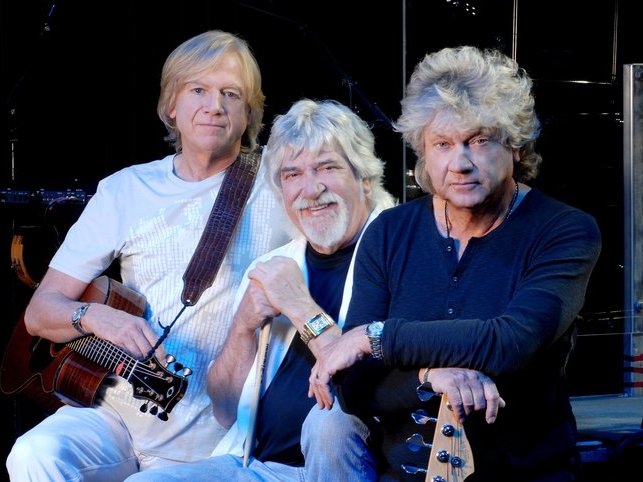When 20-year-old singer-guitarist Justin Hayward joined the Moody Blues in 1966, the band had enjoyed a modicum of success, primarily through "Go Now," a hit single that topped the British record charts while rising to number 10 in America. But the band’s inability to create original, commercially viable music was at a virtual standstill until guitarist Denny Laine and bassist Rodney Clarke exited, making room for Hayward and John Lodge.
"Fly Me High," the first single written by Hayward, failed to make any impact upon release. But the band’s next album, "Days of Future Passed" yielded "Nights in White Satin," an international hit that put the Moody Blues in a position to deliver "Your Wildest Dreams," "Ride My See-Saw," "The Story in Your Eyes," "I’m Just a Singer (In a Rock and Roll Band)" and a number of other songs from a series of hit albums released over the next two decades.
The Moody Blues 2016 tour of America began in March and will conclude on Saturday, Nov. 5 with a performance at the Milwaukee Theatre beginning at 8 p.m. In a recent interview, Hayward talked about the upcoming Milwaukee show, his latest solo album and why the Moody Blues decided not to perform at Woodstock.
OnMilwaukee: The Moody Blues have been one of the top acts in the world for 50 years. That’s a remarkable accomplishment in a business where many bands have a shelf life of two or three years.
Justin Hayward: Yeah, I think so too. We like each other, and we enjoy working together. Graeme [Edge] lives in America, and John [Lodge] has a home in the U.K. and another in Florida. I live on the French coastline of the Mediterranean. When we’re not together as the Moody Blues, we’re all off working on our own solo projects. We don’t really see each other all that much, so when we actually do get together, it’s very enjoyable. I think that’s part of the reason for our longevity. My album, "All the Way," was released three weeks ago.
What can you do on a solo album that you can’t do with the Moody Blues?
There’s a number with the London Philharmonic Orchestra, some live performance tracks, a couple of favorite Moody Blues songs done up differently, "Blue Guitar" with 10cc, "Forever Autumn" from "War of the Worlds." Things like that. There’s 15 tracks in all.
When you replaced Denny Laine in 1966, did you find big shoes to fill, or did the transition happen pretty smoothly?
I would have to say the latter. I’d been writing my own songs since I was 17, and I was influenced by Buddy Holly, the Everly Brothers, people like that. Also, U.K. pop star Marty Wilde mentored me for several years while I was in his band and encouraged me to keep writing. The Beatles and the Stones taught us all that you can be a great cover band, but if you’re to continue in the business, you have to write original material. The Moody Blues brought me, and John, on board because we were writers as well as musicians and singers.
Not many bands turned down the chance to play at Woodstock.
(laughs) Sometimes I wonder if that was a good decision or not. I’m pretty sure we’re listed on some of the posters and advertising. Ultimately we decided against playing Woodstock because we’d built a solid fan base in Europe playing the big festivals. We played in Paris the weekend of Woodstock and then returned to the Isle of Wight festival. Ironically, Bob Dylan was also booked to play Woodstock, and instead he turned up at Isle of Wight, as well.
Do you think passing on Woodstock made it harder for the band to build up an American following?
That’s why I said earlier I wondered if it was a good decision or not. I guess it really didn’t matter. We’d been brought to America by Bill Graham, who booked us in the Fillmore East and Fillmore West. I think maybe we played the Kinetic Playground in Chicago, as well. But it was the tours through mid-America, the heartland, when we opened for other bands that helped us gain an American following. Our music was getting a lot of airplay on the FM radio stations in the States, and that was a big factor in our success here.
Did you enjoy opening for any particular band?
Oh, definitely. We loved touring with Canned Heat. They were the nicest, kindest people, and they took us from Kansas all the way up into Canada.
Your first show in Milwaukee was Sept. 19, 1970, with the James Gang.
Yes, and I remember that show! Huge hall (the Arena) and pairing us with Joe Walsh’s group made for such a fun night. One of those great double-bill shows.
The band’s body of work over the last half-century is so vast. How do you choose the songs to play on tour?
You have no idea. It’s more like what songs don’t we play. Currently we’re doing shows in excess of two hours with a short intermission. The first half includes material from the last 20 years and some songs from our various solo projects. The second half of the show will consist largely of songs from the first seven albums. We have fans that’ve been with us all along, but we also get a lot of people who began following us in the late '80s and early '90s. The goal in constructing the ideal set list is to create an evening of music in which there’s something for everyone.
Is creating a set list a democratic process?
Oh, absolutely. We all have great respect for each other, and to be honest, choosing the songs to perform is fun. It gives us a chance to "rediscover" our own catalog of work. There’s so much joy in finding these songs and playing them again.







